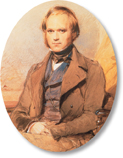16.1 Darwin's Voyage of Discovery
 What was Charles Darwin's contribution to science?
What was Charles Darwin's contribution to science? What three patterns of biodiversity did Darwin note?
What three patterns of biodiversity did Darwin note?
evolution
fossil
Preview Visuals Before you read, look at Figure 16–1. Briefly summarize the route the Beagle took.
BUILD Vocabulary
RELATED WORD FORMS In biology, the noun evolution means “the process by which organisms have changed over time.” The verb evolve means “to change over time.”
THINK ABOUT IT If you'd met young Charles Darwin, you probably wouldn't have guessed that his ideas would change the way we look at the world. As a boy, Darwin wasn't a star student. He preferred bird-watching and reading for pleasure to studying. His father once complained, “You will be a disgrace to yourself and all your family.” Yet Charles would one day come up with one of the most important scientific theories of all time—becoming far from the disgrace his father feared he would be.

Darwin's Epic Journey
 What was Charles Darwin's contribution to science?
What was Charles Darwin's contribution to science?
Charles Darwin was born in England on February 12, 1809—the same day as Abraham Lincoln. He grew up at a time when the scientific view of the natural world was shifting dramatically. Geologists were suggesting that Earth was ancient and had changed over time. Biologists were suggesting that life on Earth had also changed. The process of change over time is called evolution.  Darwin developed a scientific theory of biological evolution that explains how modern organisms evolved over long periods of time through descent from common ancestors.
Darwin developed a scientific theory of biological evolution that explains how modern organisms evolved over long periods of time through descent from common ancestors.
Darwin's journey began in 1831, when he was invited to sail on the HMS Beagle's five-year voyage along the route shown in Figure 16–1. The captain and his crew would be mapping the coastline of South America. Darwin planned to collect specimens of plants and animals. No one knew it, but this would be one of the most important scientific voyages in history. Why? Because the Beagle trip led Darwin to develop what has been called the single best idea anyone has ever had.
If you think evolution is just about explaining life's ancient history, you might wonder why it's so important. But Darwin's work offers vital insights into today's world by showing how the living world is constantly changing. That perspective helps us understand modern phenomena like drug-resistant bacteria and newly emerging diseases like avian flu.
 In Your Notebook Using what you know about ecology, explain how the ideas of a changing Earth and evolving life forms might be related.
In Your Notebook Using what you know about ecology, explain how the ideas of a changing Earth and evolving life forms might be related.

Table of Contents
- Formulas and Equations
- Applying Formulas and Equations
- Mean, Median, and Mode
- Estimation
- Using Measurements in Calculations
- Effects of Measurement Errors
- Accuracy
- Precision
- Comparing Accuracy and Precision
- Significant Figures
- Calculating With Significant Figures
- Scientific Notation
- Calculating With Scientific Notation
- Dimensional Analysis
- Applying Dimensional Analysis




